This 20-Minute Easy Pearl Couscous (also called Israeli Couscous here in the U.S.) comes together with just one pot and minimal ingredients. Prep it ahead of time and eat it up for lunch, dinner, or as a side dish.
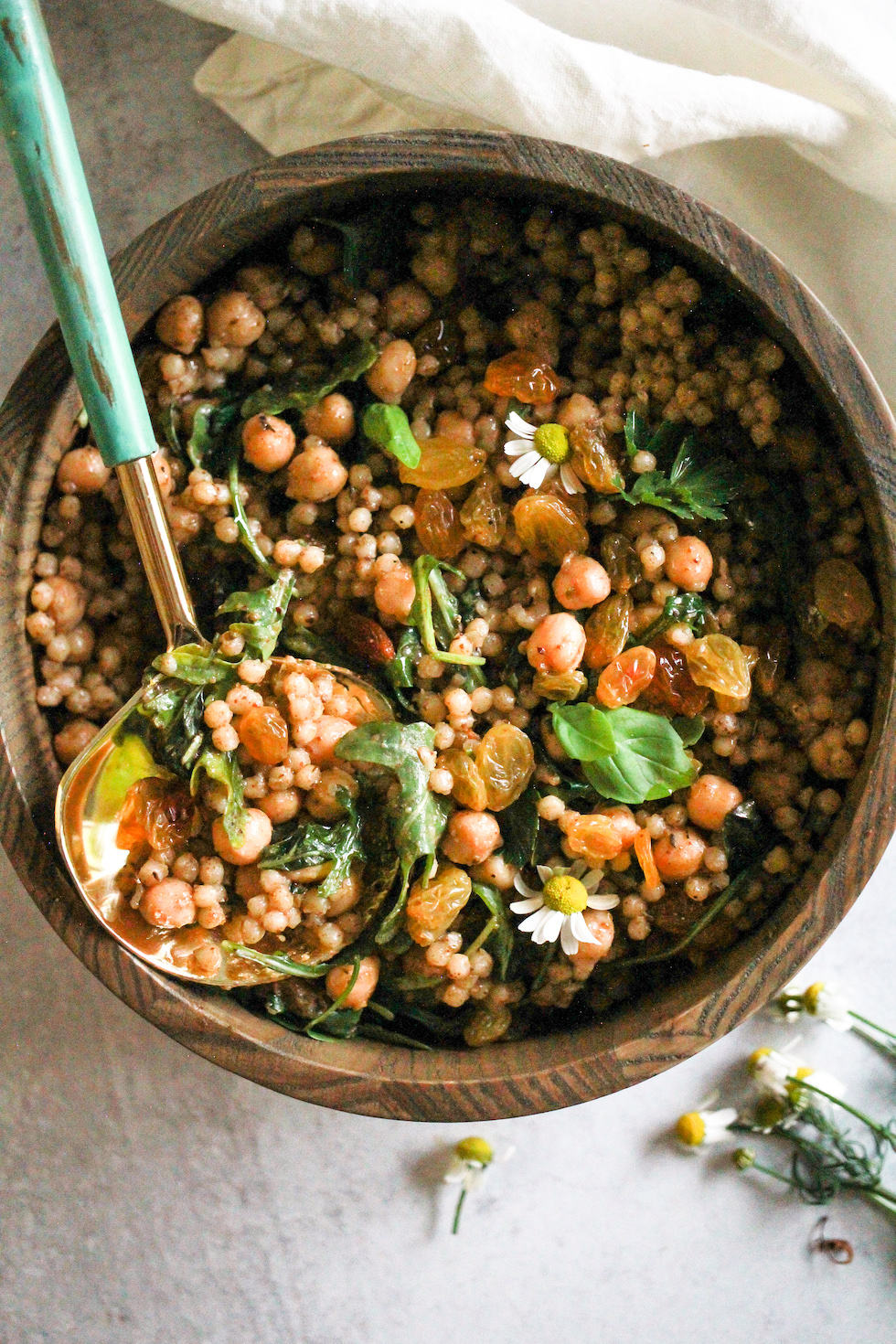
There's really no bad time to make this Pearled Israeli couscous recipe. I've even tried this couscous recipe at altitude on the camp stove. It just always hits the spot for me!
Whether I'm inside or outside, I always appreciate a simple (but still hearty and flavorful) meal that doesn't require a ton of ingredients, time, or specialized equipment.
This pearl couscous recipe is, thankfully, all of those things.
What is Pearl Couscous/Israeli Couscous?
Israeli couscous is also called pearl couscous here in the United States. It's not the same thing as traditional couscous, which originated in Northwest Africa.
Pearl "couscous" is actually a round, ball-shaped pasta made from flour and water. I learned it's a relatively recent invention, created to help alleviate food scarcity in post-war Israel. This pasta is called pearl couscous or Israeli couscous in the United States, but in Israel, it's known as Ptitim and is a popular children's food.
I like pearl couscous for this recipe because you can cook it easily and quickly, which is nice for beginners (and for camping trips when you need to get a warm meal in your belly ASAP).
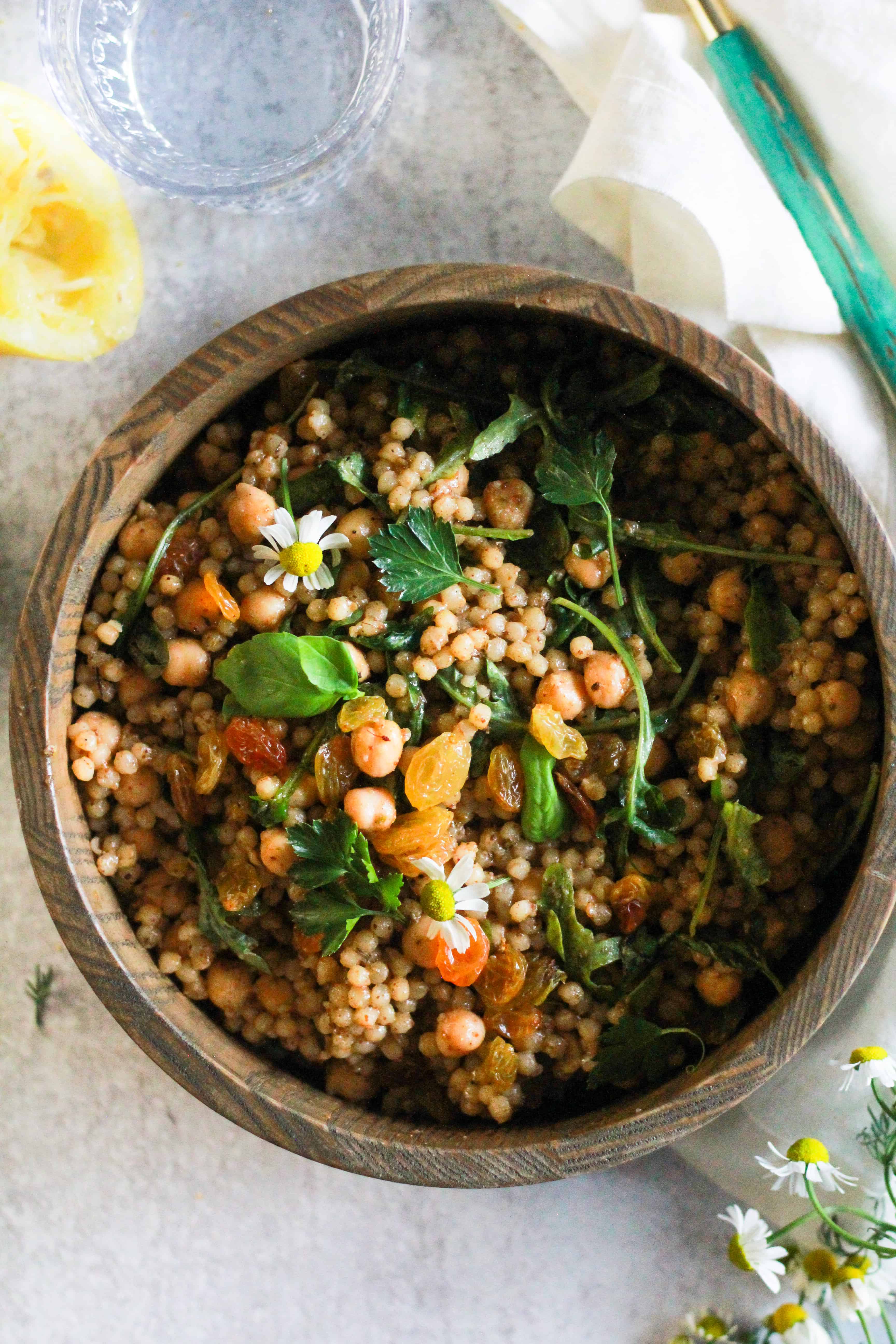
What You'll Need to Make Israeli Couscous
Ingredients:
- Pearled/Israeli couscous (sometimes sold with a flavor packet, which you can discard or save for another use)
- Vegetable broth (you could also use water)
- Chickpeas (canned, or cook dry chickpeas in advance)
- Spices: coriander, garlic powder, and za'atar (optional)
- Herbs and greens: basil, baby arugula/spinach
- Golden raisins (other types of dried fruit work, too)
- Extra virgin olive oil
- Lemon juice
Equipment:
- 4-quart (or similar size) saucepan

How to Make Pearl/Israeli Couscous
Add the couscous and vegetable broth or water to a 4-quart (or similar size) saucepan. Cover and bring to a boil over high heat. Once boiling, uncover, reduce the heat to low, and simmer for 10 minutes, or until the couscous is tender and the liquid is absorbed.
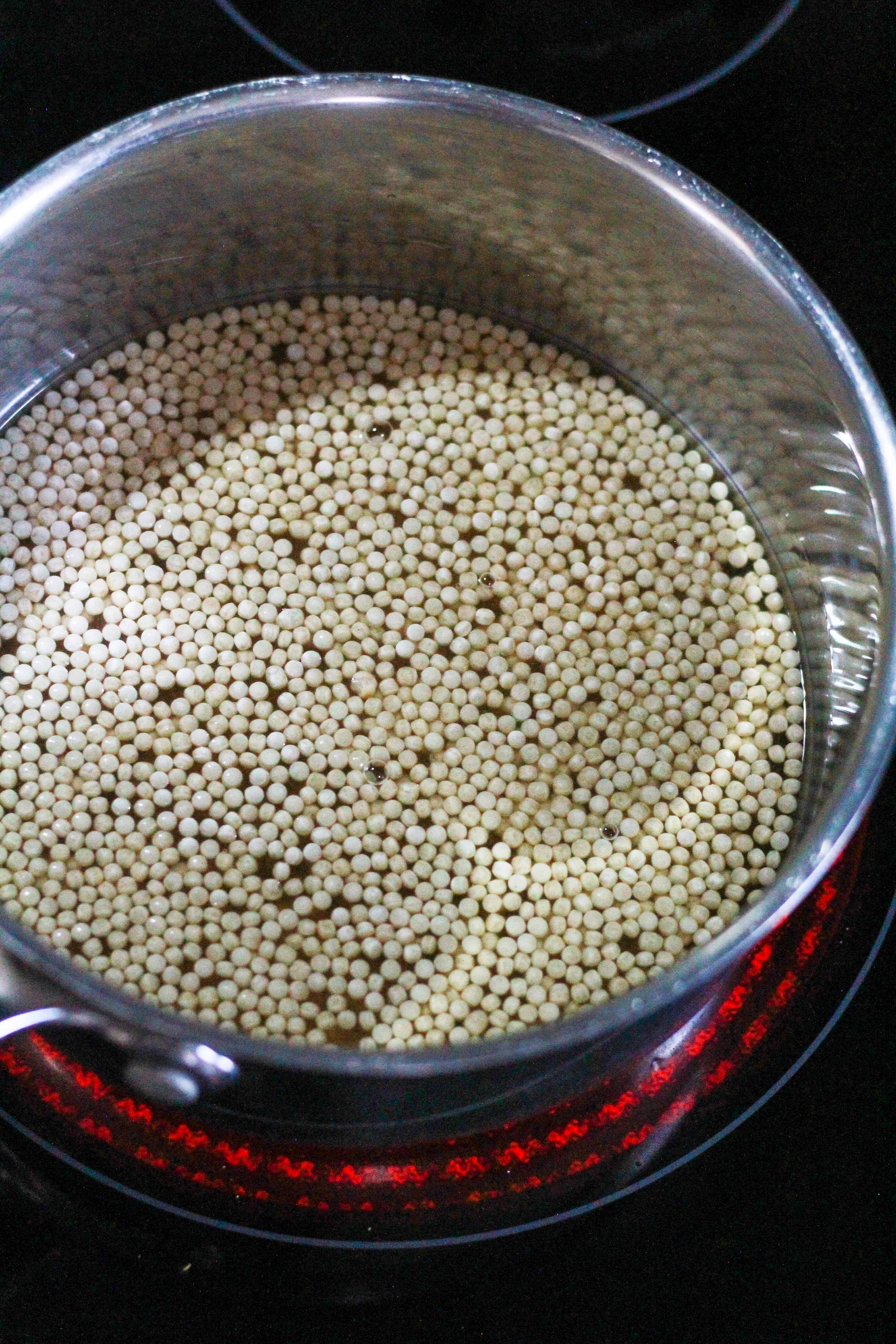
Once fully cooked, drain any excess liquid from the saucepan (if needed). If the couscous isn’t fully cooked by the time the liquid is absorbed, add a little more water and cook for a few more minutes.
After the couscous is cooked, remove the saucepan from heat and stir in the remaining ingredients: chickpeas (drain and rinse canned chickpeas first), ground coriander, za’atar (see below), garlic powder, arugula/spinach, basil, golden raisins, extra virgin olive oil, and lemon juice.
To serve, transfer the cooked Israeli couscous to a serving dish and (optionally) garnish with parsley, edible flowers, additional golden raisins, additional extra virgin olive oil, and more salt and pepper to taste if needed.
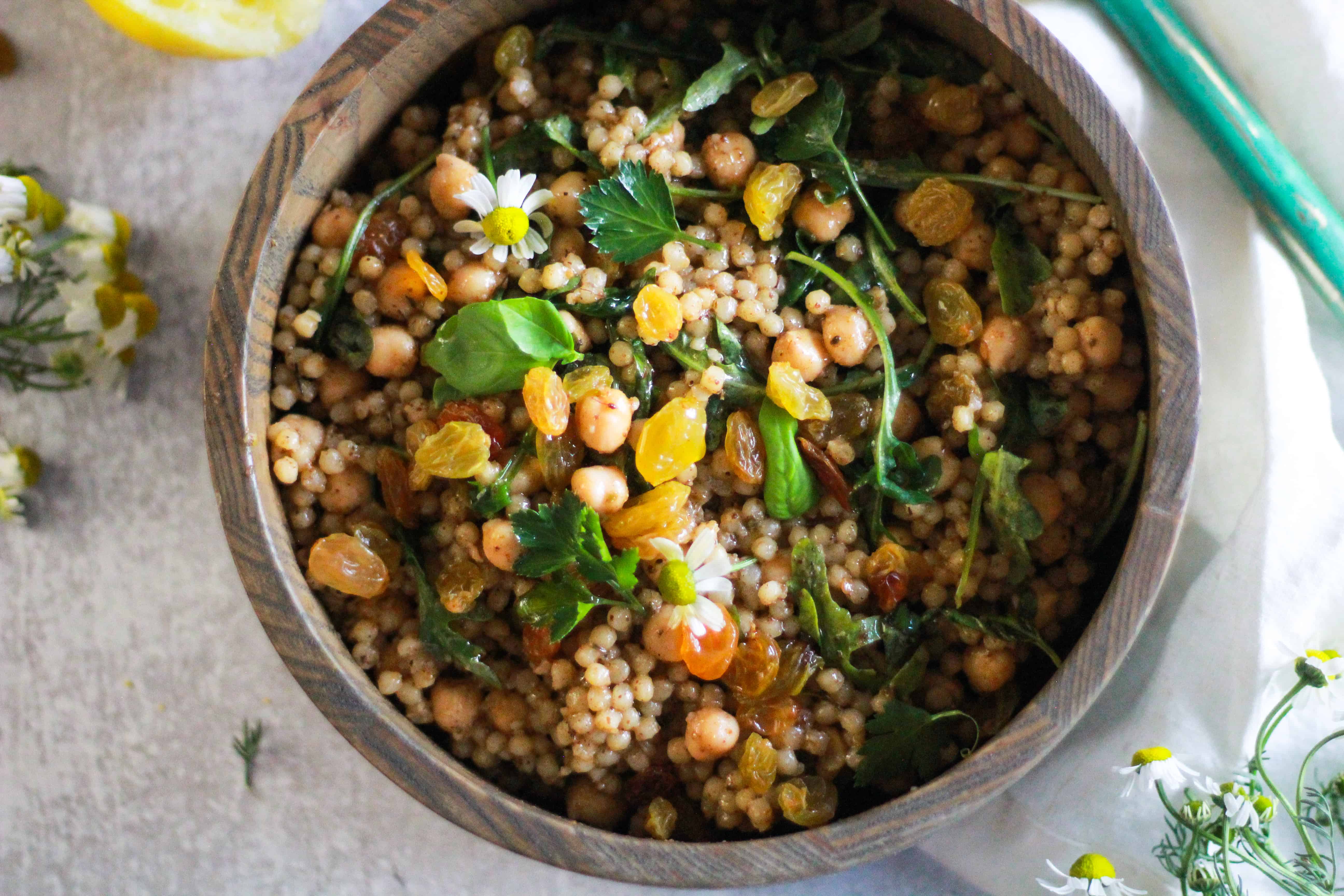
What is Za'atar?
Za’atar is a seasoning blend that typically contains sumac and sesame seeds. (Often, blends have oregano, thyme, marjoram, and salt, too.) Look for small jars of pre-mixed za’atar in the spice aisle.
It’s also okay to omit the za’atar seasoning or sub in a mix of any the above herbs if you’re not able to find it.
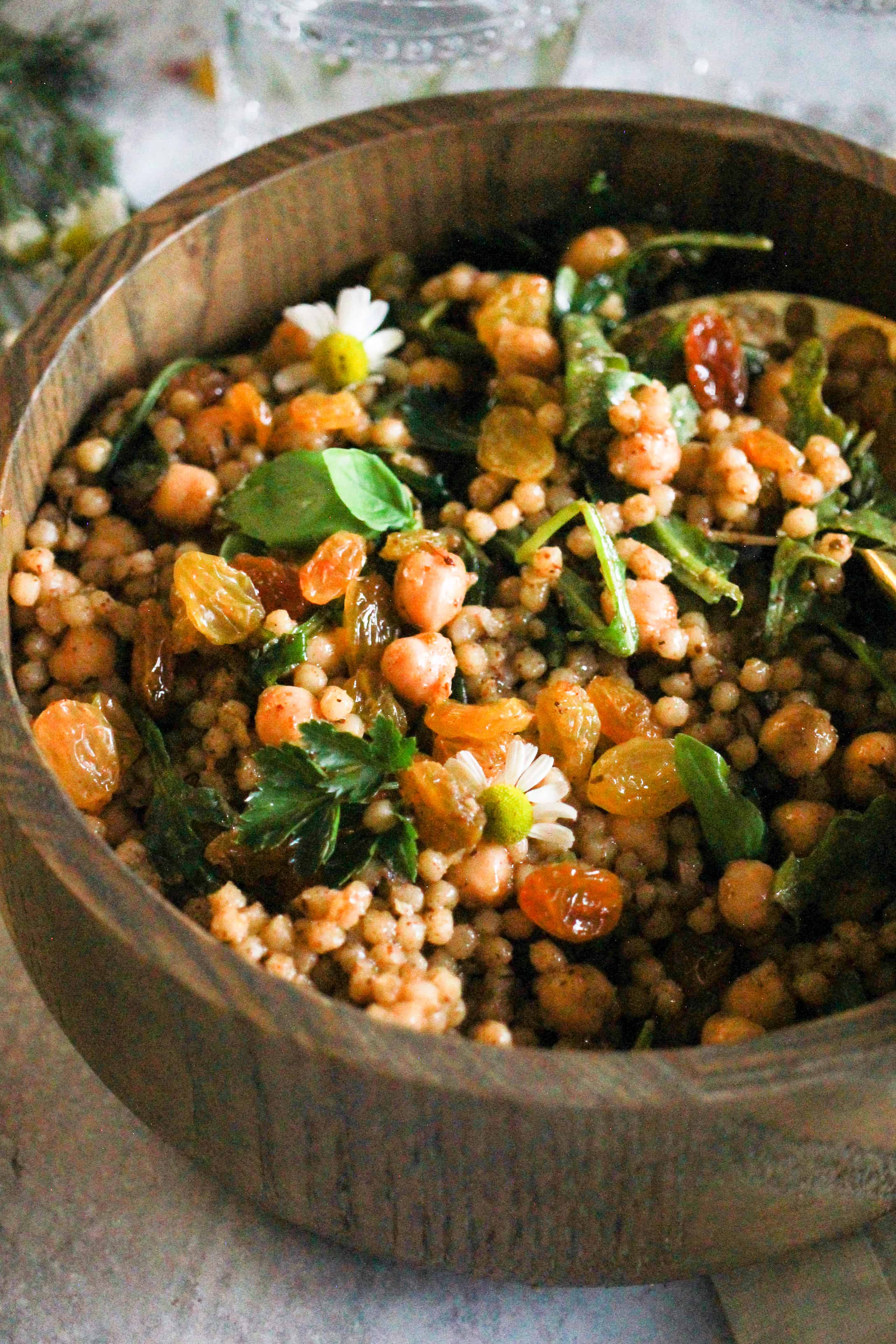
Can you substitute something else in place of the golden raisins?
If you can’t find golden raisins, substitute regular raisins, chopped dry apricots, or chopped pitted dates.
You can also leave out the dried fruit altogether, but just know the pop of sweetness from the raisins really is my favorite part.
Can you make Israeli Couscous ahead of time? What's the best way to store it?
This is a great recipe for meal prepping ahead of time. Store the prepared couscous in an airtight container and refrigerate for up to one week.
If the couscous seems dry after storage, stir in a little olive oil and/or lemon juice before serving.
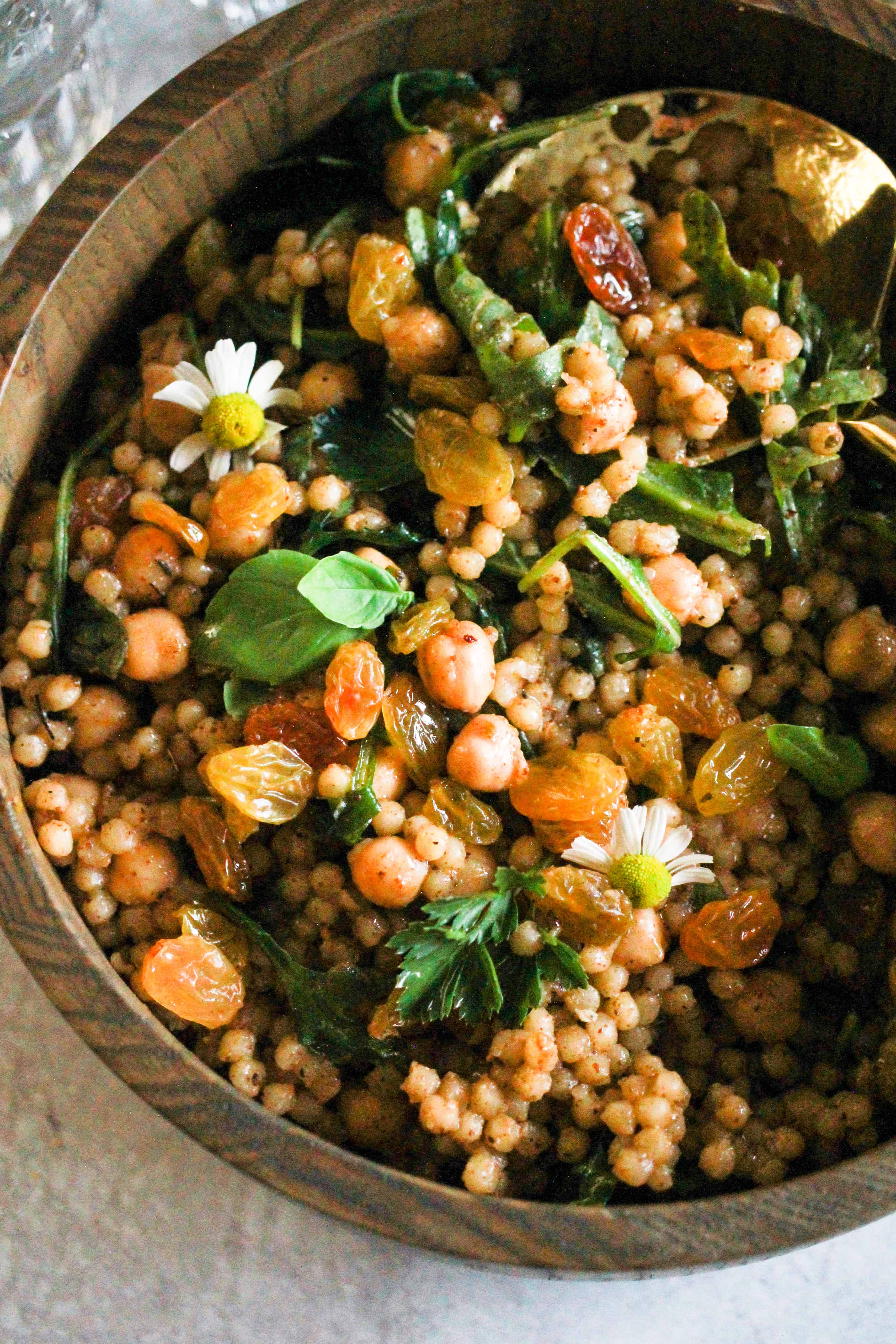
📖 Recipe
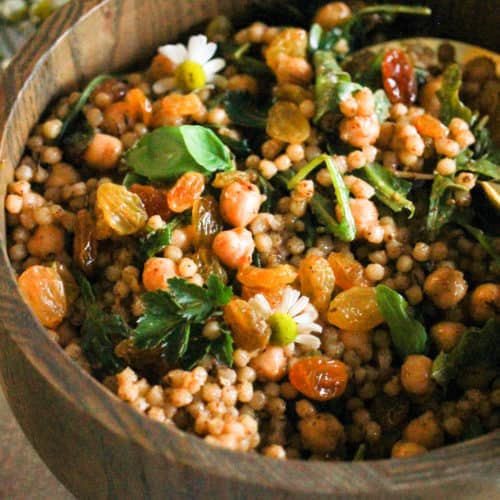
Easy Israeli Couscous
Equipment
- 4-quart saucepan, stovetop
Ingredients
Couscous:
- 1 cup dry Israeli couscous (also called pearl couscous), see note
- 1 ½ cups vegetable broth or water
- 1 15-ounce can chickpeas, drained and rinsed
- 1 tablespoon ground coriander
- 1 tablespoon za’atar (see note)
- 1 teaspoon garlic powder
- ½ cup baby arugula or spinach
- ¼ cup fresh basil
- 2 tablespoons golden raisins (see note)
- 1 tablespoon extra virgin olive oil
- 1 tablespoon lemon juice
Optional for serving:
- Parsley
- Edible flowers
- Golden raisins
- Extra virgin olive oil
- Salt and pepper
Instructions
- Add Israeli couscous and vegetable broth or water to a 4-quart saucepan, cover, and bring to a boil over high heat. Once boiling, uncover, reduce the heat to low, and simmer for 10 minutes, or until the couscous is tender and the liquid is absorbed. (Once fully cooked, drain any excess liquid from the saucepan if needed. If the couscous isn’t fully cooked by the time the liquid is absorbed, add ¼ cup of water and continue cooking.)
- After the couscous is cooked, remove the saucepan from heat and stir in chickpeas, coriander, za’atar, garlic powder, arugula or spinach, basil, golden raisins, extra virgin olive oil, and lemon juice. Transfer couscous to a serving dish and garnish with parsley, edible flowers, additional golden raisins, additional extra virgin olive oil, and salt and pepper if desired.
- Store Israeli couscous in an airtight container and refrigerate for up to 1 week. If the couscous seems dry after storage, stir in more olive oil before serving.

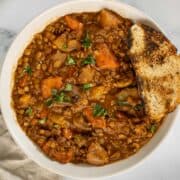
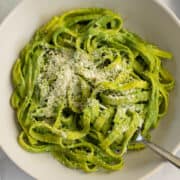

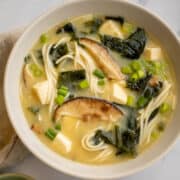
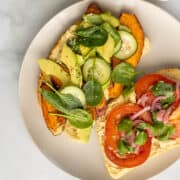
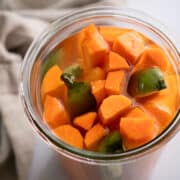
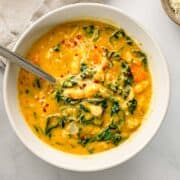
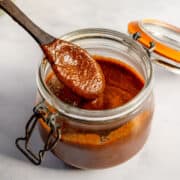
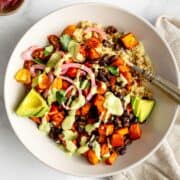
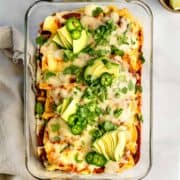


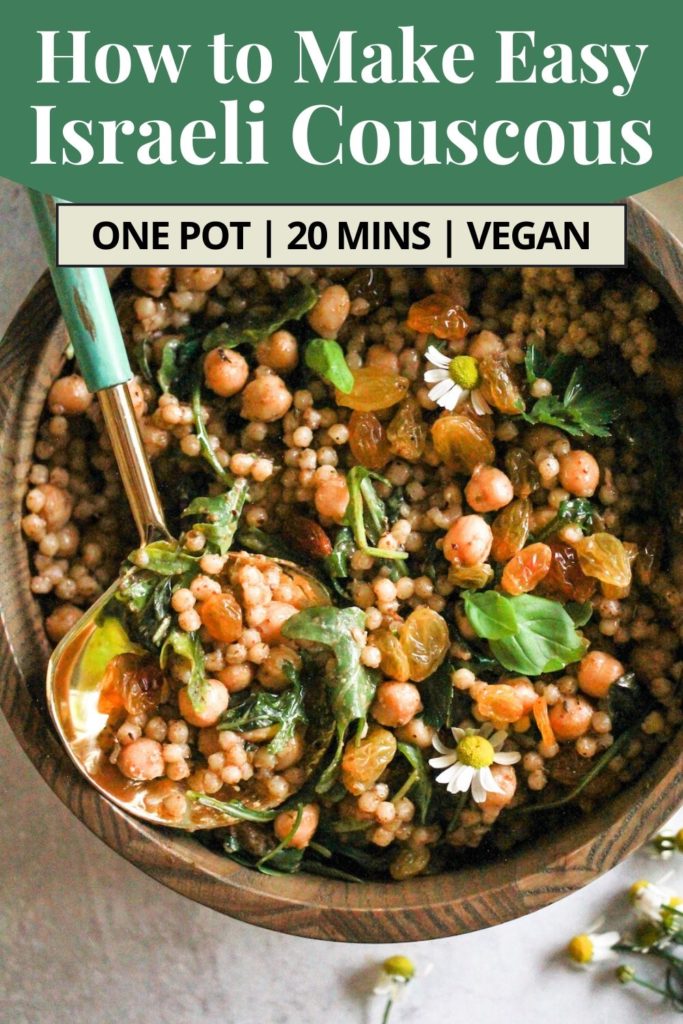
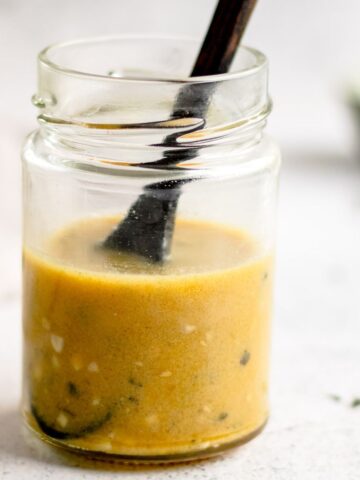
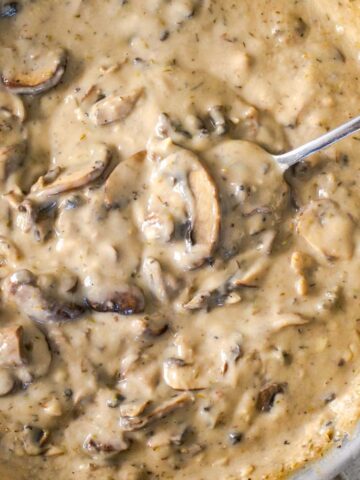
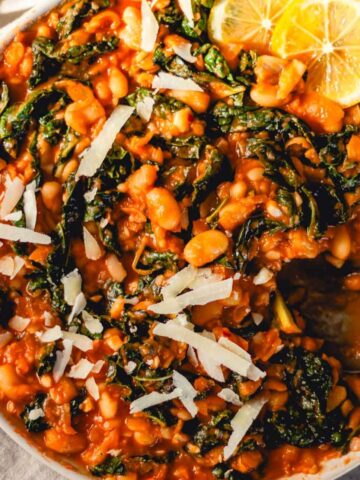
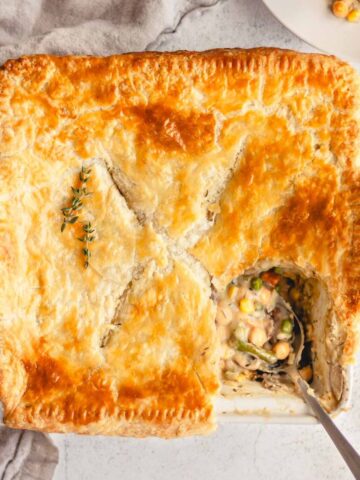
Mizz P says
This is SO good! My only change was that I was out of raisins of any sort and substituted dried cranberries. I used frozen, chopped spinach and it worked just fine. I also used low-sodium vegetable stock and low-sodium garbanzo beans and realized the dressing is so tasty that it completely eliminated the "need" for salt! This is great warm (winter) or cool on a bed of greens/lettuce (summer.) I could see adding crumbled (low-fat) feta or maybe goat cheese as well. I also think this could work well with regular (i.e., not pearl) couscous. This would also be really nice for a potluck as it is so very easy and it is "different" but not "weird" and would appeal to a lot of people. Bookmarked!!!
Stephanie McKercher, RDN says
Thanks so much for your comment! I agree this would be a great potluck/party dish! 🙂
Samantha says
I never post comments on recipes but I loved this one so so much. Thank you!
Stephanie McKercher, RDN says
So glad you enjoyed it, Samantha! Appreciate the comment and rating! 🙂
Jenny Jones says
My cousin gave me a container of pearl couscous, and I was searching for a recipe. This is the one I will try, and thank you for sharing it. I can't help but add that the comment area nettled me; snobbery coming from people that think they know everything, and it's their duty to let other folks know how wrong they are. I'd like to point out that this is a recipe post, ladies and gentlemen. This gracious gal Stephanie was very thorough, and the information is well written. I'm sure there are plenty of other websites people can go to for negativity. This one is about how to cook FOOD. So saying that, thank you Stephanie for showing me how to cook my pearl couscous 🙂
Stephanie McKercher, RDN says
Thanks, Jenny! Let me know what you think of the recipe once you give it a try! 🙂
Stacey says
I made this one tonight and it is simply delightful. Thanks for the lovely dinner!
Stephanie McKercher, RDN says
You're welcome, Stacey! So glad you enjoyed it!
Christine says
Beautiful pictures and great recipe. I'm going to make this tonight. I'm going to use some dried apricots and I've got lots of fresh basil so I'll amp that up. Thank you!
Stephanie McKercher, RDN says
Thanks, Christine! Enjoy the recipe!
Sharon says
This is just so amusing! That is NOT COUSCOUS! I know because I am Israeli living in Israel. THAT is something called Ptitim (prounounced Pteeteem with the emphasis on the second syllable) - and it is a staple food for children in Israel. Many people make the pasta, which is what Pteetem are, and add ketchup butter or veggies to it.
Couscous is a GRAIN! It is kind of like when I came to Israel and there was this thing called American Peanuts - which I had NEVER seen in America - such is Israeli Couscous.
I suppose the best explanation I have found is here:
https://en.wikipedia.org/wiki/Couscous
That being said, your salad looks delightful and I suppose one could make it with ANY type of pasta, not just Ptitim.
I will try it and be more than happy to give you my feedback.
Stephanie McKercher, RDN says
Hi Sharon, thanks so much for your feedback. I'm aware that this is NOT traditional couscous, but rather a type of pasta. (I tried to explain that in my post but I think my launguage may be confusing, so I apologize for that!... "Israeli couscous is a round, ball-shaped pasta made from flour and water. I learned it’s a relatively recent invention, created to help alleviate food scarcity in post-war Israel. Israeli couscous is different than true couscous, which is smaller in size and has been around for centuries."
I did read that this pasta is called Ptitim in Israel and that it's a common children's food (this is the article where I found some of my info: https://www.pri.org/stories/2014-03-11/israeli-couscous-gourmet-ingredient-only-minds-american-chefs.)
Here in the US, the pasta in question is labeled as "Israeli Couscous" on the box, so I chose to use that name for my recipe in an effort to help my (mostly US-based audience) find the right ingredients. However, I want to ensure I'm being respectful and sharing accurate info, so always appreciate reader feedback.
Maybe I could label this as an Israeli Couscous Pasta Salad or call it an Israeli Couscous (Ptitim) Salad.
I'm open to ideas and thank you for taking the time to comment!
Stephanie
Stephanie McKercher, RDN says
I also added this sentence to my post to hopefully make the distinction more clear.
(Edit: in Israel, this type of pasta is known as Ptitim and is a popular children's food.)
Thank you again!
miriam zerrouki says
israeli couscous is nat a new dish ;it come from algeria . its bèrère dish please get you fact strait
Stephanie McKercher, RDN says
Hi Miriam, thanks for taking the time to comment! I spent some time reading about true couscous versus Israeli couscous before writing this post and from what I learned, they're different from each other in a couple of ways. As far as I understand, traditional couscous originated in Northern Africa many centuries ago, and "Israeli Couscous" was invented later, during the 20th century, in Israel. I linked to one of the articles I found (from pri.org) that talks about this. From my experience, Israeli couscous (which is how it's labeled on the package I use) is also larger in size and cooks faster than traditional couscous. Do you happen to know which type is used in the traditional bèrère dish you mentioned? I tried searching for the recipe but wasn't able to find it, and the Algerian dishes I found seem to use the traditional type of couscous. If you have references or any additional information about this, I'd love to look it over and correct my post if needed. My email address is [email protected]. Thank you so much! Stephanie
Stephanie McKercher, RDN says
Hello, I wanted to let you know I made some edits to my post to further explain that this is not the same as traditional couscous, which originated in Northwest Africa. I try to explain more clearly that the ingredient is labeled as "Pearl Couscous" or "Israeli Couscous" here in the United States, and that it is known by other names elsewhere. Thank you again for your feedback. I'm happy to consider additional edits as necessary.